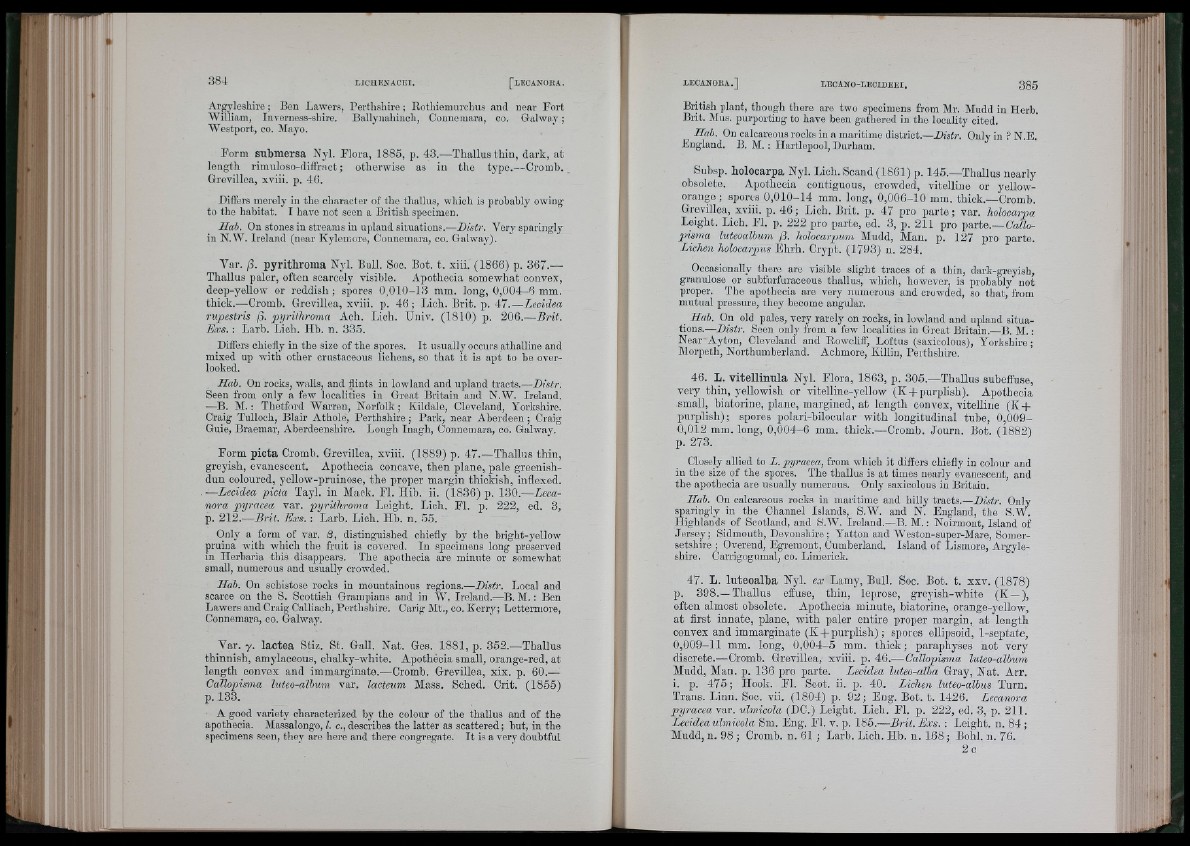
Argyleshii’o ; Ben Lawer.s, rertlislrire ; Rothienmrelius and near Fort
William, Inverness-shire. Ballyiiahinch, Coimemara, co. Galway ;
AVestport, co. Mayo.
Form suhmersa Nyl. Flora, 1885, p. 43.— Thallus thin, dark, at
length rimuloso-diffract ; otherwise as in th e typo.—Cromb.
Grevillea, xviii. p. 46.
Differs merely in the character of the thallus, which is probably owing
to the habitat. I liave not seen a British specimen.
Hah. On stones iu streams in upland situations.—Histr. Very sparingly
iu N.W. Ireland (near Kylemore, Connemara, co. Galway).
Var. ft. pyrithroma Nyl. Bull. Soo. Bot. t. xiii. (1866) p. 367.—
Thallus paler, often scarcely visible. Apothecia somewhat convex,
deep-yellow or reddish ; spores 0 ,0 1 0 -1 3 mm. long, 0 ,0 0 4 -6 mm.
thiok.—Cromb. Grevillea, xviii. p. 4 6 ; Lioh. B rit. p. 4 7 .—Lecidea
rupestris ft. p y rithroma Aoh. Lioh. Ilniv. (1810) p. 2 06.—B r it.
E.vs. : Larb. Lioh. Hb. n. 335.
Differs chiefly in tlie size of the spores. It usually occurs athalline and
mixed up with other crustaceous lichens, so th at it is apt to be overlooked.
Hab. Ou rocks, walls, and flints in lowland and upland tracts.—Histr.
Seen from only a few localities iu Great Britain and N.W. Ireland.
—B. M. : Thetford Warren, Norfolk ; Kildale, Cleveland, Yorkshire.
Craig Tulloch, Blair Athole, Perthshire ; Park, near Aberdeen ; Craig
Guie, Braemar, Aberdeenshire. Lough Inagh, Connemara, co. Galway.
Form picta Cromb. Grevillea, xviii. (1889) p. 4 7 .—Thallus th in ,
greyish, evanescent. Apotheoia concave, then plane, pale greenish-
dun coloured, yellow-pruinose, th e proper margin thickish, inflexed.
— Lecidea picta Tayl. in Mack. Fl. Hib. ii. (1836) p. 130.—Ijeca-
nora pyracea var. pyrithroma Leight. Lioh. F l. p. 222, ed. 3,
p. 212.— Brit. Exs. : Larb. Lioh. Hb. n. 55.
Only a form of var. B, distinguished chiefly by the bright-yellow
pruina with which the fruit is covered. Iu specimens long preserved
in Herbaria this disappears. The apothecia are minute or somewhat
small, numerous and usually crowded.
Hab. On schistose rocks iu mountainous regions.—Histr. Local and
scarce on the S. Scottish Grampians and in W. Ireland.—B. M. : Ben
Lawers and Craig Calliach, Perthshire. Carig Mt., co. Kerry; Lettermore,
Connemara, co. Galway.
A’ar. y. lactea Stiz. St. Gall. Nat. Ges. 1881, p. 352.—Thallus
th innish, amylaceous, chalky-white. Apothéoia small, orange-red, a t
length convex and immarginate.—Cromb. Grevillea, xix. p. 60.—
Callopisma luteo-alhum var. lacteum Mass. Sched. Crit. (1855)
p. 133.
A good variety characterized hy the colour of the thallus and of the
apothecia. Massalongo, I. c., describes the latter as scattered; but, in the
specimens seen, they are here and there congregate. I t is a very doubtful
British plant, though there are two specimens from Mr. Mudd in Herb.
Brit. Mus. purporting to have beeu gathered in the locality cited.
^ Hab. On calcareous rocks iu a maritime district.—Histr. Only in ? N.E.
Englaud. B. M. ; Hartlepool, Durham.
Subsp. holocarpa Nyl. Lioh. Soand (1861) p. 145.—Thallus nearly
obsolete. Apotheoia contiguous, crowded, vitelline or yellow-
orange ; spores 0 ,0 1 0 -1 4 mm. long, 0 ,0 0 6 -1 0 mm. thick.—Cromb.
Grevillea, xviii. p. 4 6 ; Lioh. Brit. p. 47 pro p a r te ; var. holocarpa
Leight. Lich. F l. p. 222 pro parte, ed. 3, p. 211 pro p a rte .— C/iZo-
2 >isma luteoalbum ft. holocarpum Mudd, Man. p. 127 pro parte.
Liehen holocarpus Eh rh . Crypt. (1793) n. 284.
Occasionally there are visible slight traces of a thin, dark-greyish,
granulose or suhfurfuraceous thallus, which, however, is probably not
proper. The apothecia are very numerous aud crowded, so that, from
mutual pressure, they become angular.
^ Hab. On old pales, very rarely on rocks, in lowland and upland situations.—
Histr. Seen only from a few localities in Great Britain.—B. M .:
Near Ayton, Cleveland and Rowcliif, Loftus (sa.Yicolous), Yorkshire;
Morpeth, Northumherland. Achmore, Killin, Deithshire.
46. L. vitellinula Nyl. Flora, 1863, p. 305.—ThaUus subefluse,
very th in , yellowish or vitelline-yellow (K + purplish). Apothecia
small, biatorine, plane, margined, a t length convex, vitelline (K +
p urplish); spores polari-bilocular w ith longitudinal tube, 0 ,0 0 9 -
0,012 mm. long, 0 ,0 0 4 -6 mm. th ick .— Cromb. Journ. Bot. (1882)
p. 273.
Closely allied to L. pyracea, from which it difiers chiefly iu colour and
iu the size of the spores. The thallus is at times nearly evanescent, aud
the apothecia are usually numerous. Only saxicolous in Britain.
Hab. Ou calcareous rocks in maritime and hilly tracts.—Histr. Only
sparingly in the Channel Islands, S.W. and N. England, the S.W.
Highlands of Scotland, and S.AA’. Ireland.—B. M .; Noirmont, Island of
Jersey; Sidmouth, Devoushire ; Yatton and AA’eston-super-Mare, Somersetshire
; Overend, Egremont, Cumherland. Island of Lismore, Argyleshire.
Carrigogumal, co. Limerick.
47. L. luteoalba Nyl. ex Lamy, Bull. Soc. Bot. t. xxv. (1878)
p. 3 9 8 .—Thallus effuse, th in , leprose, groyish-white (K —),
often almost obsolete. Apothecia minute, biatorine, orange-yellow,
a t first in nate, plane, w ith paler entire proper margin, a t length
convex and immarginate (K + p u rp lish ); spores ellipsoid, 1-septate,
0.0 0 9 -1 1 mm. long, 0 ,0 0 4 -5 mm. th ic k ; paraphyses no t very
discrete.—Cromb. Grevillea, xviii. p. 46.— Callopisma luteo-album
Mudd, Man. p. 136 pro parte. Lecidea lateo-alba Gray, Nat. Arr.
1. p. 4 7 5 ; Hook. FL Soot. ii. p. 40. Lichen luteo-albus Turn.
Trans. Linn. Soc. vii. (1804) p. 9 2 ; Eng. Bot. t. 1426. Lecanora
pyracea Yar. idmicola (DC.) Leight. Lioh. F l. p. 222, ed. 3, p. 211.
Lecidea ulmicola Sm. Eng. El. v. p. 185.—B r it. Exs. : Leight. n. 84 ;
Mudd, n. 98 ; Cromb. n. 6 1 ; Larb. Lioh. Hb. n. 1 6 8 ; Bohl. n. 76.
2 0